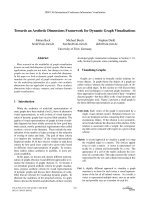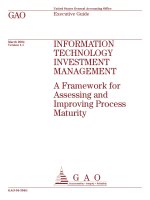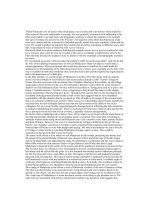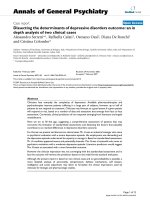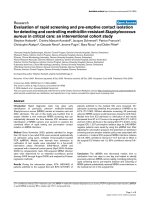- Trang chủ >>
- Đại cương >>
- Kinh tế vĩ mô
insider computer fraud an in depth framework for detecting and defending against insider it attacks
Bạn đang xem bản rút gọn của tài liệu. Xem và tải ngay bản đầy đủ của tài liệu tại đây (4.93 MB, 506 trang )
INSIDER
COMPUTER
FRAUD
AN IN-DEPTH FRAMEWORK
FOR DETECTING AND DEFENDING
AGAINST INSIDER IT ATTACKS
AU4659.indb 1 11/1/07 12:01:03 PM
AU4659.indb 2 11/1/07 12:01:03 PM
INSIDER
COMPUTER
FRAUD
AN IN-DEPTH FRAMEWORK
FOR DETECTING AND DEFENDING
AGAINST INSIDER IT ATTACKS
Kenneth C. Brancik
Boca Raton New York
Auerbach Publications is an imprint of the
Taylor & Francis Group, an informa business
AU4659.indb 3 11/1/07 12:01:03 PM
The fundamental research and writing of this book preceded my employment at VerizonBusiness.
The opinions, analysis, and writings are my own and were based on my computer science research
as a former Doctoral student at Pace University, New York.
Auerbach Publications
Taylor & Francis Group
6000 Broken Sound Parkway NW, Suite 300
Boca Raton, FL 33487-2742
© 2008 by Taylor & Francis Group, LLC
Auerbach is an imprint of Taylor & Francis Group, an Informa business
No claim to original U.S. Government works
Printed in the United States of America on acid-free paper
10 9 8 7 6 5 4 3 2 1
International Standard Book Number-13: 978-1-4200-4659-5 (Hardcover)
This book contains information obtained from authentic and highly regarded sources. Reprinted
material is quoted with permission, and sources are indicated. A wide variety of references are
listed. Reasonable efforts have been made to publish reliable data and information, but the author
and the publisher cannot assume responsibility for the validity of all materials or for the conse-
quences of their use.
Except as permitted under U.S. Copyright Law, no part of this book may be reprinted, reproduced,
transmitted, or utilized in any form by any electronic, mechanical, or other means, now known or
hereafter invented, including photocopying, microfilming, and recording, or in any information
storage or retrieval system, without written permission from the publishers.
For permission to photocopy or use material electronically from this work, please access www.
copyright.com ( or contact the Copyright Clearance Center, Inc. (CCC)
222 Rosewood Drive, Danvers, MA 01923, 978-750-8400. CCC is a not-for-profit organization that
provides licenses and registration for a variety of users. For organizations that have been granted a
photocopy license by the CCC, a separate system of payment has been arranged.
Trademark Notice: Product or corporate names may be trademarks or registered trademarks, and
are used only for identification and explanation without intent to infringe.
Library of Congress Cataloging-in-Publication Data
Brancik, Kenneth C.
Insider computer fraud : an in-depth framework for detecting and defending
against insider IT attacks / Kenneth Brancik.
p. cm.
Includes bibliographical references and index.
ISBN 978-1-4200-4659-5 (alk. paper)
1. Computer security . 2. Computer crimes. I. Title.
QA76.9.A25B725 2007
005.8 dc22 2007017696
Visit the Taylor & Francis Web site at
and the Auerbach Web site at
T&F_LOC_A_Master.indd 1 10/31/07 2:52:04 PM
AU4659.indb 4 11/1/07 12:01:03 PM
Dedication
is book is dedicated to my Mother, who took care of four young adults; when
my Father passed away early in my life, she was suddenly forced to reenter the job
market, while still providing her family the care and support we all needed during
our growing years through adulthood. I owe my strong work ethic and dedication
to my personal goals to her and the good example she has demonstrated over many
years as a supportive parent.
AU4659.indb 5 11/1/07 12:01:04 PM
AU4659.indb 6 11/1/07 12:01:04 PM
vii
Contents
Preface xvii
Key Features xix
Organization of the Book xxiii
About the Author xxxi
Acknowledgments xxxiii
Chapter 1 Insider Computer Fraud (ICF) 1
1.1 Introduction 1
1.2 e Primary Accomplishments of is Book 1
1.3 An Overview of Insider Computer Fraud 3
1.3.1 Insider Defined 3
1.3.2 Fundamental Elements of Computer Fraud 4
1.4 Insider reat Concepts and Concerns 4
1.5 Defense in Depth 6
1.6 Conclusion 8
Reference 8
Chapter 2
Related Research in Insider Computer Fraud and
Information Security Controls 9
2.1 Introduction 9
2.2 Insider reat Study: Illicit Cyber Activity in the Banking
and Finance Sector 11
2.3 A Framework for Understanding and Predicting Insider
Attacks 12
2.4 Methodology for the Optimization of Resources in the
Detection of Computer Fraud 14
2.5 Managing the Insider reat 18
2.5.1 Authentication 18
2.5.2 Privileges 18
AU4659.indb 7 11/1/07 12:01:04 PM
viii ◾ Contents
2.5.3 Physical Security Issues 19
2.5.4 Warning Signs 20
2.5.5 HTTP Tunneling 20
2.6 Conclusion 21
Additional Resources 22
References 26
Chapter 3
e Insider reat Strategic Planning Process 27
3.1 Introduction 27
3.2 Security Objectives 28
3.3 Understanding the Information Security Governance Process 30
3.4 Cyber-Security Risk Governance Processes for Web-Based
Application Protection (Understanding the External Risks
and Internal Information Security Risks) 30
3.5 e Risk Management Process (Risk 101—Concepts) 32
3.5.1 What Should Be Included in the Risk Management
Process? 33
3.5.2 e Tailored Risk Integrated Process (TRIP) 33
3.5.2.1 Broad-Brush Approach (Macro Approach) 34
3.5.2.2 e Recommended Integrated Business/
Technology Approach (Application
to Infrastructure) 35
3.5.2.3 e TRIP Strategy 36
3.6 Security Controls in Application Systems Controls (ISO
27001) 37
3.6.1 Security in Application Systems Controls Needs to Be
Clearly Articulated within an InfoSec Policy 37
3.7 Security and SOX 404 Designated Applications and Systems 41
3.8 Application Risk Weightings for Criticality Factors Report 41
3.9 e Inherent Risk Valuation Report 41
3.10 An Example of Various Web Application reats 43
3.11 An Example of a Risk Ranking of Critical Production
Applications 46
3.12 e Risk Assessment HeatMap 46
3.13 e Risk Assessment (Acceptance) Process 48
3.14 Net Residual Risk (NRR) 52
3.14.1 Probability of Occurrence 52
3.14.2 Business Impact Assessment (BIA) 53
3.14.3 Business Continuity Planning 53
3.15 Application-Based Controls: e 2005 Global Technology
Audit Guide (GTAG), e Institute of Internal Auditors (IIA) 54
3.15.1 Application Controls 54
3.15.1.1 BS ISO/IEC 27001:2005 54
AU4659.indb 8 11/1/07 12:01:04 PM
Contents ◾ ix
3.16 Laws, Rules, and Regulations 57
3.16.1 H.R. 4127 (Data Accountability and Trust Act
[DATA]) October 25, 2005 58
3.16.2 Notification of Information Security Breach 58
3.17 Critical Path of NPPI and Core Business Transactions 60
3.17.1 NPPI Data 60
3.18 Information Security eory and Control Point Identification 60
3.19 Control Points and the Key Risk Indicator (KRI) 61
3.20 e Relationship between KRIs, Control Points, and IT
Infrastructure 61
3.21 e Relationship between the Risk Evaluation Process and the
Defense in Depth (DiD) Efficiency Calculation 62
3.22 Background on the Origin of Bayes’ eorem and Practical
InfoSec Application of the eorem Using the DiD Efficiency
Calculation 62
3.23 Determining an Applications Residual Risk (Inherent Risk-
Mitigating Controls) 63
3.24 Determining an Application’s Net Residual Risk (Inherent
Risk-Mitigating Controls ± IT Infrastructure and Software
Controls (Optimizers) 64
3.25 A Quantitative Analysis (Defense in Depth Efficiency
Calculation) 64
3.25.1 Step 1: Complete the Application Control Point
Ratings Matrix 64
3.25.2 Step 2: Complete the IT Infrastructure and Software
Control Point Rating Matrix Operating System
(Application Security Optimizer) 65
3.25.2.1 Network Perimeter (Application Security
Optimizer) 68
3.25.3 Step 3: Calculate the DiD Security Effectiveness
Percentage Using All Five Layers of Protection and
with Two Out of the Five Layers of Protection 71
3.25.3.1 Scenario 1: Calculating the Defense in Depth
Security Efficiency Ratio with Five Layers 73
3.25.3.2 Scenario 2: Calculating the Defense in
Depth Security Efficiency Ratio with Only
Two Layers of Defense 74
3.25.4 Step 4: Assign a Qualitative Rating to the Total
Defense in Depth Security Efficiency Percentage 76
3.25.5 Step 5: Perform an Update on the reat Modeling
Rating Based on the Results of the Defense in Depth
Calculation and the Net Residual Risk Rating Assessment . 76
3.26 e reat Assessment Process (e Integration Process) 77
AU4659.indb 9 11/1/07 12:01:04 PM
x ◾ Contents
3.27 Critical Applications or Systems 79
3.28 e Strategic Planning Process for Reducing the Insider reat 79
3.29 e reat Assessment Matrix 81
3.30 e reat Assessment Rating Reference Table 82
3.30.1 Performing an Application and Code Review Penetration
Test for Web-Based and Web Services Applications 93
3.30.2 e Information Security Scorecard 93
3.31 Develop Security Patterns for Applications/Systems Software
Engineering (Process and Product Improvements) 95
3.31.1 Security Pattern (Risk Assessment and Management) 96
3.31.2 Motivation 96
3.31.3 Problem 96
3.31.4 Forces 97
3.31.5 Solution 97
3.31.6 Consequences 98
3.31.7 Known Uses 98
3.31.8 Related Patterns 98
3.32 e Strategic, Legal, and Operational Risk Assessment 99
3.33 Implemented Software Engineering InfoSec Process and
Product Improvements 100
3.34 Conclusion 100
References 101
Chapter 4 Information Technology Architecture and Insider
Computer Fraud Prevention 103
4.1 Introduction 103
4.2 Components of an Information Technology Infrastructure 103
4.3 A Primer for Enterprise Architecture Using Zachman’s
Framework—Architectural Strategies to Prevent and Detect ICF 105
4.4 e Zachman Framework 106
4.5 Types of System Architectural Designs for Information
Processing 108
4.5.1 Service Oriented Architecture (SOA) 109
4.5.2 Centralized Processing 109
4.5.3 Distributive Systems Architecture 111
4.5.4 Client–Server Architecture 111
4.6 Conclusion 112
References 112
Chapter 5 Protection of Web Sites from Insider Abuse and the
Information Technology Infrastructure 113
5.1 Introduction 113
5.2 Insider Attacks 113
AU4659.indb 10 11/1/07 12:01:05 PM
Contents ◾ xi
5.3 Intrusion Detection Systems, Vulnerability Assessments, and
Other Network Testing 114
5.4 Network Intrustion Detection Systems (NIDS)—Strengths
and Weaknesses 114
5.4.1 Strengths 114
5.4.2 Weaknesses 115
5.5 Host-Based Intrusion Detection Systems (HIDS)—Strengths
and Weaknesses 115
5.5.1 Host IDS (HIDS) 116
5.5.1.1 Strengths—HIDS 116
5.5.1.2 Weaknesses 116
5.5.2 Vulnerability Assessment Phases 117
5.5.2.1 Planning 117
5.5.2.2 Discovery 117
5.5.2.3 Mapping and Identifying Active Devices on
the Network 117
5.6 e Penetration Testing Process 118
5.6.1 Goals 118
5.6.2 Methodology 118
5.7 Firewall Security 120
5.7.1 What Is a Firewall? 120
5.7.2 Address Screening Routers 120
5.7.3 Circuit-Level Gateway 120
5.7.4 Application-Level Gateway 121
5.7.5 Stateful Inspection Gateway 121
5.8 Conclusion 121
Chapter 6 Web Services Security and Control Considerations
for Reducing Transaction Risks 123
6.1 Introduction 123
6.2 Web Services Security for a Service Oriented Architecture 124
6.3 Web Services and the Financial Services Sector 124
6.4 Major Groups Involved in Establishing Standards for Web
Services Security 125
6.5 Current Uses of Web Services 126
6.6 Web Services Security—Industry Concerns 126
6.7 Web Services Security—General Concerns 127
6.8 Web Services Security—Technical Security Concerns 127
6.8.1 Security Assertion Markup Language (SAML) 127
6.8.2 Specific Types of Web Services Security Solutions 128
6.9 Extensible Markup Language (XML) 129
6.10 XML and Security 130
6.11 Simple Object Access Protocol (SOAP) 131
AU4659.indb 11 11/1/07 12:01:05 PM
xii ◾ Contents
6.12 SOAP and Security 131
6.13 Problems with Web Services Security 131
6.14 Administration 132
6.15 Conclusion 133
Chapter 7 Application Security and Methods for Reducing Insider
Computer Fraud 135
7.1 Introduction 135
7.2 An Overview of Application Security 136
7.3 e Current State of Application Security and the Prevention
and Detection of the Insider reat 136
7.4 Application Security and the Federal Insider reat Study 137
7.5 e Application Risk Assessment Process and Net Residual Risk 138
7.6 Software Engineering Considerations for Ensuring Application
Security 140
7.6.1 National Institute of Standards and Technology
(NIST) Special Publication (SP) 800-64 176
7.6.1.1 Security Considerations in the Initiation
Phase 176
7.6.1.2 Security Considerations of the Operations/
Maintenance Phase 177
7.6.1.3 Security Considerations of the Disposition
Phase 178
7.6.2 ICF Framework 178
7.7 e Risk Assessment Process and ICF Prevention and Detection 179
7.7.1 Inherent Risk Rating: ICF reat Assessment (ICFTA) 181
7.7.2 Risk Assessment Rating (Cyber-Security
HealthCheck) 181
7.8 Developing Application-Specific Acceptable and Unacceptable
Use Policies 181
7.9 Conclusion 182
References 183
Chapter 8 Insider Computer Fraud Taxonomy and the Art of the
Key Fraud Indicator (KFI) Selection Process 185
8.1 Introduction 185
8.2 Insider Computer Fraud (ICF) Taxonomy 186
8.2.1 e Nexus between Software Vulnerabilities,
Application Security, Taxonomy, and ICF 186
8.2.1.1 Software Vulnerabilities and ICF 186
8.2.1.2 Application Security and ICF 186
8.2.2 Software Vulnerabilities, Application Security,
Taxonomy, and ICF Prevention and Detection 187
AU4659.indb 12 11/1/07 12:01:06 PM
Contents ◾ xiii
8.2.3 Ontology 188
8.2.4 Taxonomy 188
8.2.5 Customized Taxonomies for Detecting ICF 190
8.2.6 Practical Uses of the Customized Applications
Taxonomies for Detecting ICF 191
8.2.7 Customized Taxonomies for Detecting ICF—e
Universal ICF Taxonomy 191
8.2.7.1 Macro Computer Fraud Taxonomy 191
8.2.7.2 Micro Insider Computer Loan Fraud
Taxonomy 194
8.2.7.3 Insider Loan Taxonomy (KFI and KFM) 194
8.2.8 Forensic Foto Frame Taxonomy (Source: Kenneth C.
Brancik) 196
8.2.9 Metadata Taxonomy 196
8.2.10 ICF Taxonomy (Summary Report) 198
8.2.11 ICF Taxonomy (Decomposition—ICF Case Analysis) 198
8.2.12 Insider Computer Fraud Taxonomy—ICF Cases 205
8.3 Misuse of Typical Application Features 233
8.4 Conclusion 235
References 235
Chapter 9 Key Fraud Signature (KFS) Selection Process
for Detecting Insider Computer Fraud 237
9.1 Introduction 237
9.2 KFS Selection Process 238
9.2.1 KFS Background 238
9.2.1.1 Phase I: Asset Risk Prioritization 239
9.2.1.2 Phase II: Data Criticality 239
9.2.1.3 Phase III: Taxonomy (Macro) of ICF 240
9.2.1.4 Phase IV: Taxonomy (Micro) of ICF 241
9.2.1.5 Phase V: KFSAR Process 243
9.2.2 e Neural Network and the Key Fraud Signature
Association Rules (KFSAR) Criteria 245
9.2.2.1 e KFS Candidate Preparation Document
and Its Interrelationship to Other Documents 245
9.2.2.2 Timing of KFS Development 246
9.2.3 Accounting Forensics 247
9.2.3.1 Example of KFSAR (Macro and Micro ICF
Taxonomy)—Insider Loan Fraud Scenario 248
9.2.3.2 Forensic Foto Frame 261
9.2.3.3 A Key Fraud Signature (KFS) 261
9.3 Conclusion 312
AU4659.indb 13 11/1/07 12:01:06 PM
xiv ◾ Contents
Chapter 10 Application and System Journaling and the Software
Engineering Process 313
10.1 Introduction 313
10.2 Selection Strategies for Application and System Journaling for
the Software Engineering Process 314
10.2.1 Overview 314
10.2.2 Data Monitoring 314
10.2.3 Introduction—Journaling 316
10.2.4 Introduction—Computer Forensics 316
10.2.5 Journaling and Computer Forensics—
Interrelationships 316
10.2.6 Computer Forensics/Journaling and Computer
Incident Response (Interrelationships) 317
10.2.6.1 Types of Evidence 318
10.2.6.2 Compliance Control 320
10.2.7 Current Research on Logging and Fraud Detection 320
10.2.8 e Federal Financial Institution Examination
Council (FFIEC) 321
10.2.9 General Criteria for Journaling/Audit Trails 322
10.2.10 e National Industrial Security Program Operating
Manual (NISPOM) 323
10.2.10.1 8-602, Audit Capability 323
10.2.10.2 Audit 1 Requirements 323
10.2.10.3 Audit 2 Requirements 324
10.2.10.4 Audit 3 Requirements 324
10.2.10.5 Audit 4 Requirements 324
10.2.11 Journaling: Web Servers 324
10.2.12 Journaling: Network Security 326
10.2.13 Firewalls 326
10.2.14 Journaling: Operating Systems (UNIX) 327
10.2.15 System Logs 327
10.2.16 Journaling: Operating Systems (NT) 328
10.2.17 Journaling: Mainframe (ACF2) 328
10.2.18 ICF Journaling Workflow Diagram and Descriptions 329
10.3 Journaling Risk/Controls Matrix (An Overview) 332
10.4 Metadata 333
10.5 A Taxonomy of Metadata 333
10.5.1 Metadata Extraction (Standardized Logging Criteria
for Forensic Foto Frames) 335
10.6 Journaling Risk/Controls Matrix 337
10.7 Conclusion 345
References 345
AU4659.indb 14 11/1/07 12:01:06 PM
Contents ◾ xv
Chapter 11 e Role of Neural Networks in the Insider Computer
Fraud Framework 347
11.1 Introduction 347
11.2 e Concept of Artificial Intelligence and Neural Network 348
11.2.1 Neural Networks 348
11.2.1.1 Statistical Models 348
11.2.2 Artificial Neural Network (ANN) (Software
Computing Techniques and Components) 349
11.2.2.1 Perceptrons 349
11.2.2.2 Competitive Layers 349
11.2.2.3 Self-Organizing Maps (SOMs) 350
11.2.2.4 Differences between Artificial Intelligence
(AI) and Neural Nets 350
11.2.3 A Graphical Illustration—Distributed Processing 350
11.3 Designing the Neural Network 351
11.3.1 Learning Laws 351
11.3.2 Supervised Training 351
11.3.3 Unsupervised Training 352
11.3.4 Lazy Learning 353
11.4 Neural Associative Memory (NAM) 354
11.4.1 Overview 354
11.4.2 NAM Characteristics 354
11.4.3 A NAM Example 354
11.4.4 Advantages of Associative Memories 355
11.4.5 Types of Associative Memories 355
11.5 Memory Creation—Similarities between the Human Brain
versus the Neural Network 356
11.6 e Human Brain—e Cerebrum or Neocortex 356
11.7 Neurons 357
11.8 e Novelty Neural Network—Linkage between the Human
Brain and the Experimental Portion of is Research 358
11.9 Novelty Detection (Saffron Technologies) 359
11.10 e SaffronOne Associative Memory 359
11.11 Confidence Level 360
11.12 Use of Neural Networks for Monitoring Anomaly Detection 360
11.13 Neural Networks and ICF 361
11.14 Computer Forensic Benefits of Neural Networks 361
11.14.1 e Neural Network Development Process 361
11.15 Research Efforts in Intrusion Detection Systems-Based Neural
Networks 362
11.16 Anomaly Detection Using Neural Networks (Fuzzy Clustering) 362
11.17 Misuse Detection Using Neural Networks 363
AU4659.indb 15 11/1/07 12:01:07 PM
xvi ◾ Contents
11.18 Preprocessing Activities 363
11.19 Conducting Edit and Validation Activities to Ensure Data
Integrity 364
11.20 Data Postprocessing 364
11.21 Increasing the Sensitivity of the Neural Network to Absolute
Value Change 365
11.22 Postprocessing 365
11.23 Benford’s Law 365
11.24 Future Neural Network Trends 368
11.25 Conclusion 368
References 369
Appendix A Application Access Controls 371
Appendix B Application Data Origination/Input 391
Appendix C Application Data Processing 403
Appendix D Application Output/Management Information System
(MIS) 409
Appendix E Key Fraud Signature (KFS) Worksheet 417
Appendix F Cyber-Security HealthCheck 423
Appendix G Acronym List 441
Appendix H Glossary 445
Contributors 455
Index 457
AU4659.indb 16 11/1/07 12:01:07 PM
xvii
Preface
e insider threat has for too long been overlooked by many organizations in con-
ducting their risk assessments and threat analysis processes. e financial and repu-
tation risks may be high for organizations who fall victim to nefarious activities of
an insider involving current or former employees, contractors, or perhaps trusted
clients who are afforded similar access rights to applications, systems, and data as
an employee; and the cost of ignoring preventative security solutions could become
comparatively even higher in the long-term.
Information security concerns do not typically evaporate over time, but rather
can evolve from what appears to be an isolated problem, to a systemic risk that has
enterprise-wide implications. e enterprise-wide information security risks can be
created by both external and internal threats; however, the latter risk is typically
overlooked by many organizations. In an organization, the absence of evaluating
the risks posed by the insider threat can have a deleterious effect on the information
security governance process and can cause many negative consequences, including
an increased level of risk to operations, finance, reputation, and strategy.
e absence of an effective information security governance process may lend
itself to increased regulatory oversight, particularly when the risk involves the need
for ensuring the safeguarding of sensitive nonpublic private information (NPPI)
data. e need to safeguard NPPI data from both internal and external threats is
also the focus of numerous states imposing breach notification laws and the pending
federal legislation (Data Accountability and Trust Act [DATA]), which will man-
date customer breach notification involving unauthorized access to NPPI data.
All roads within Insider Computer Fraud: An In-Depth Framework for Detecting
and Defending against Insider IT Attacks point to the importance of maintaining
strong security controls first. en, using completed comprehensive and integrated
data flow diagrams, the transactions transmission and storage life cycle (critical
path) will be traced. e critical path will show the transmission and ultimate stor-
age of NPPI and critical core transaction data elements, which will be useful for
determining the assigned control points throughout the critical path where access
controls, data origination and input, processing, and output controls exist.
Kenneth C. Brancik, PhD, CISA, CISSP, ITIL
AU4659.indb 17 11/1/07 12:01:07 PM
AU4659.indb 18 11/1/07 12:01:07 PM
xix
Key Features
e primary goal of this book is to introduce the reader to the topic and problem of
insider computer fraud (ICF), and to suggest a practical framework or methodol-
ogy that can be used by any private-sector organization or government agency for
identifying, measuring, monitoring, and controlling the risks associated with the
insider threat. is book is not intended to offer a prescriptive process that requires
a series of steps, which absolutely must be performed in order to benefit from any
one step or process that is discussed in the ICF framework. e layers within the
“Defense in Depth Model” used to mitigate ICF risks will be management’s deci-
sion based on the results of their risk and privacy assessment; threat modeling;
and decision to accept, transfer, or mitigate that risk. is book is not intended to
provide exhaustive controls assessment for applications, systems, or any separate
component of the information technology (IT) infrastructure of an organization.
However, a horizontal analysis of application and system related risks is provided,
and the interrelationships between an application and the IT infrastructure compo-
nents it uses to transmit, process, and store the data will be demonstrated.
e book is process driven, to help in understanding both management and
technical controls and how the two operating in concert have a positive synergistic
impact in reducing ICF activity as well as reducing the risks over external threats.
Although the primary thrust of the book focuses on the insider threat, many of the
risks and controls apply equally to both internal and external threats in varying
degrees. ere is a symbiotic relationship that exists between the risks, controls,
threats, and action plans that should be deployed to enhance overall information
security governance processes.
e material presented will be beneficial to not only management, but the audit
and compliance community as well. Where appropriate, the integrated risk assess-
ment approach used to identify, measure, monitor, and control risks will aid audi-
tors, compliance and privacy officers, regulatory examiners, and others who seek
sound and best practices over the risk management process.
Based on the minimal amount of data available within the public domain on
the insider threat and computer fraud, one of the primary goals of this book is to
provide an orientation on an elusive topic for which the information is either not
AU4659.indb 19 11/1/07 12:01:07 PM
xx ◾ Key Features
readily available or the data may lack the credibility to justify the development of
a risk management strategy and action plans. e mitigation and prevention of
financial losses associated with the insider threat can be mitigated or, hopefully,
prevented if management deploys the appropriate safeguards based almost exclu-
sively on deploying the Defense in Depth concept, with its foundation based on
logic, cost effectiveness, and management’s appetite or tolerance for risk.
e reader of this book will gain a familiarity with the following concepts that
are all related to understanding the risks and controls surrounding ICF activity:
Strategic Planning Process ◾ : e Insider reat Strategic Planning Process is
discussed in detail.
Risk Governance Process ◾ : How an effective risk governance process for identi-
fying ICF activity should be implemented is discussed.
Risk Categorization and Assessment ◾ : e differences and similarities in deter-
mining inherent, residual, and net residual risk and how to integrate the
threat assessment process into the risk assessment process are presented.
Risk and reat Assessment Processes ◾ : e interrelationship between the risk
assessment and the threat assessment processes is covered.
e Defense in Depth Model and Security Efficiency Calculation ◾ : Using Bayes’
eorem, the efficiency and effectiveness of each layer of protection in the
Defense in Depth Model are quantified to assist management in their infor-
mation security (InfoSec) strategic planning and risk reduction processes for
both internal and external threats.
Application Security ◾ : Industry sound and best practices are discussed in con-
text with interrelated risks found within other IT infrastructure components
and software (optimizers).
Penetration Testing ◾ : Penetration testing criteria for Web-based applications,
which could leave those applications vulnerable to both internal and external
threats, are addressed.
Web Services Security ◾ : Web services and supporting applications introduce
security risks for internal and external threats. e knowledgeable insider
can have greater access to and internal knowledge of the Service Oriented
Architecture of an enterprise, which supports the use of Web services and
the development activities of the applications and systems used to transmit
data and messaging, leaving those applications and systems with an increased
vulnerability.
Insider Computer Fraud Identification ◾ : e importance of using various diag-
nostic tools for assessing ICF misuse detection using key risk indicators is dis-
cussed in detail. e key risk indicators include key fraud indicators (KFIs),
key fraud metrics (KFMs), and key fraud signatures (KFSs), based on per-
forming macro and micro taxonomies of a critical application.
AU4659.indb 20 11/1/07 12:01:08 PM
Key Features ◾ xxi
Control Point Identification and Forensic Foto Frames ◾ : Based on the critical
path of nonpublic private information (NPPI) and core data elements of
transaction data of critical applications, control points (access controls, data
origination and input, processing, and output) can be identified, measured,
monitored, and controlled through data capture activity and other means.
e data capture activity will be performed through the execution of the
Forensic Foto Frame process that will collect key data by taking a “snapshot”
of that data at stated control points. e snapshot of the data will be collected
by the continuous Forensic Foto Frame process, and over time it will provide
the necessary data to conduct an analysis of the normalcy of the captured
data’s behavior. e primary goal of the Forensic Foto Frame process is the
profiling of the data versus the initial profiling of the behavioral character-
istics of the insider. e behavioral characteristics or data profiling process
will take the absolute values of each Forensic Foto Frame captured and begin
the process of analyzing data normalcy in the context of a given set of vari-
ables. e variables may include but not be limited to the name of the insider
who executed the transaction or processed the data. e metadata will also
be analyzed for normalcy based on its description of various characteristics
about the data, such as the time of day that the data was entered into the
system and other relevant information. e data analysis can then assess the
behavior of the captured data and metadata for negative patterns or trends
(such as spikes) in absolute value changes and conclude on suspected insider
misuse detection.
Application Journaling ◾ : e importance of application and IT infrastructure
journaling is addressed in terms of its importance in the detection of ICF
activity, the collection of computer forensics evidentiary data and metadata
for event correlation purposes, root cause analysis, and strengthening the
software engineering processes to “Bake” InfoSec journaling criteria and
requirements within the software engineering and application development
life cycle. In general, journaling is an important component of the eDiscovery
process, which became law at the end of 2006.
Privacy ◾ : e increasing emphasis on regulatory compliance through the Sar-
banes–Oxley Act, section 404 (SOX 404), Gramm–Leach–Bliley Act (GLB),
Health Insurance Portability and Accountability Act (HIPAA), and other
legislation and guidance have placed growing attention on ensuring the con-
fidentiality, integrity, and availability of NPPI and core transaction data. A
discussion of the importance of performing a privacy impact assessment, and
data flow diagramming the critical path of NPPI and core transaction data
between critical systems internally and externally is also examined.
ICF Anomaly Detection ◾ : e use of emerging technology through artificial
intelligence, such as a novelty neural network that learns through neural
associative memory (NAM), which can profile the behavior of data and
metadata to flag anomalies in the behavior of data, which is instrumental in
AU4659.indb 21 11/1/07 12:01:08 PM
xxii ◾ Key Features
determining day zero insider threats involving data and metadata manipula-
tion, is explored.
Information Security Pattern Analysis ◾ : e use of security patterns has been
gaining some level of traction in recent years. A discussion on how the use of
these security software design and procedural patterns may assist in the iden-
tification and resolution of enterprise-wide high-risk threats is presented. e
pattern development and analysis will be partly based on management’s clear
problem definition, context identification, forces determined, and finally a
viable solution that can be used to mitigate both insider and external security
threats.
Unfortunately, the insider threat topic, even though it is significant in terms
of its impact on an organization’s operational, financial, and reputation risk areas,
has not yet reached critical mass in terms the public’s awareness of insider risks and
mitigating controls. Although there may be varying degrees of research into the
insider threat problem, the absence of a large volume of credible writing on this
topic and the general absence of a significant number of solution providers who
offer a means for identifying, measuring, monitoring, and controlling risks associ-
ated with the insider threat remains a concern.
My goal in writing this book was to increase the awareness and importance
of understanding the associated risks and controls involving the insider threat. By
writing this book, I am confident that the volume of credible research and secu-
rity solutions will occur in the near future and will incite an increased level of
research, funding, and solution development activities. is book, together with
other research available in the public domain, may serve as a stimulus for creating
both public- and private-sector partnerships between corporations and state, local,
and federal governments and the academic community. e INFOSEC Research
Council (IRC) in their 2005 Hard Problems lists ranks the insider threat problem
as number two, which I am hoping will spur an increased level of academic and
professional research into this area. In 2007, I have observed a significant increase
in interest for the topic of the insider threat. is year, I have been involved two
workshops on the insider threat problem. e workshop participants include both
the public and private sectors, along with academia involvement.
AU4659.indb 22 11/1/07 12:01:08 PM
xxiii
Organization of the Book
e following chapter summaries provide abstracts for each of the chapters within
this book to allow the reader to focus on key chapters; however, it is highly recom-
mended that the chapters be read in sequence, because the structure of the book is
designed such that each chapter serves as a building block to each of the subsequent
chapters in the book.
Chapter 1: Insider Computer Fraud
is introductory chapter provides an overview of insider computer fraud (ICF)
and discusses the interrelationships between various chapters and related content
contained throughout the book. ere is discussion regarding the importance of
developing and maintaining a robust risk assessment methodology, which serves
as the prerequisite bedrock needed for developing Insider Computer Fraud: An In-
Depth Framework for Detecting and Defending against Insider IT Attacks. e chap-
ter provides a high-level synopsis of key chapters within the book which relates to
and has a connection with an integrated risk assessment process. e Defense in
Depth concept is a vital component within this book in context to its relevance and
importance to other related topics discussed throughout the book.
Chapter 2: Related Research in Insider Computer
Fraud and Information Security Controls
is chapter provides a high-level survey of key research and writing conducted on
the topic of the insider threat. One of the more significant contributions to bringing
increased attention to the insider threat was achieved in the Insider reat Study
prepared by the U.S. Secret Service and Carnegie Mellon’s Software Engineering
Institute. A previously unpublished article by omas Kellerman also provides
insight into the insider threat problem and discusses authentication, privileges,
physical security issues, and various warning signs.
AU4659.indb 23 11/1/07 12:01:08 PM
xxiv ◾ Organization of the Book
Chapter 3: The Insider Threat
Strategic Planning Process
is chapter provides a comprehensive review on a number of different areas related
to the insider threat. e topic of strategic planning is broken down into a number
of different processes and practices, which are woven together within this extensive
chapter. e content provides the foundational knowledge needed to understand
and apply the concepts presented within all the subsequent chapters. e sections
of this chapter include, but are not limited to the following key areas: defining
security objectives; understanding the security governance and risk management
governance processes; the tailored risk integrated process (TRIP); application criti-
cality determination and security; qualitative and quantitative risk ratings; inher-
ent, residual, and net residual risk ratings; threat modeling; the Risk Assessment
Heatmap and InfoSec Scorecard; industry sound and best security practices; data
privacy legislation and the privacy impact assessment; data flow diagramming and
determining the critical path of data; control point determination and key risk
indicators (KRI); the Defense in Depth Efficiency Calculation; the strategic plan-
ning process for the insider threat; the Web-based application penetration test-
ing process; utilizing software security design and procedural patterns for problem
identification and solutions; determining the strategic, legal, and operational risk
assessment; and developing strategies for implementing software engineering Info-
Sec process and product improvements.
Chapter 4: Information Technology Architecture
and Insider Computer Fraud Prevention
is chapter focuses on the importance of a Risk-Based Information Technology
Architecture for reat Mitigation. An introduction to the components of a typical
information technology infrastructure is also presented. Specifically, a high-level
introductory discussion of typical IT infrastructure components include firewalls,
packet filters, application gateways, routers, hosts, servers, PC workstations, and
intrusion detection systems. e Zachman Architectural Framework is discussed
in the context of preventing and detecting insider computer fraud activities. Also
provided is an introduction to the types of systems and architectural designs for
information processing, which includes Service Oriented Architecture (SOA) and
Centralized Processing and Distributive Systems Architecture including Client–
Server Architecture. Particular emphasis is placed on SOA, given its significance to
illustrating how the Forensic Foto Frame concept works for ICF detection.
AU4659.indb 24 11/1/07 12:01:09 PM


